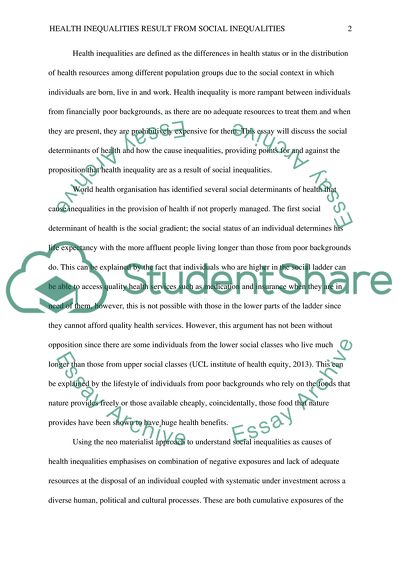Cite this document
(Health Inequalities Result from Social Inequalities Coursework, n.d.)
Health Inequalities Result from Social Inequalities Coursework. https://studentshare.org/health-sciences-medicine/1804546-health-inequalities-result-from-social-inequalities-action-on-health-inequalities-requires-action-across-all-the-social-determinants-of-health-fair-society-healthy-lives-the-marmot-review-2010-p15-1-critically-discuss-this-statement-provi
Health Inequalities Result from Social Inequalities Coursework. https://studentshare.org/health-sciences-medicine/1804546-health-inequalities-result-from-social-inequalities-action-on-health-inequalities-requires-action-across-all-the-social-determinants-of-health-fair-society-healthy-lives-the-marmot-review-2010-p15-1-critically-discuss-this-statement-provi
(Health Inequalities Result from Social Inequalities Coursework)
Health Inequalities Result from Social Inequalities Coursework. https://studentshare.org/health-sciences-medicine/1804546-health-inequalities-result-from-social-inequalities-action-on-health-inequalities-requires-action-across-all-the-social-determinants-of-health-fair-society-healthy-lives-the-marmot-review-2010-p15-1-critically-discuss-this-statement-provi.
Health Inequalities Result from Social Inequalities Coursework. https://studentshare.org/health-sciences-medicine/1804546-health-inequalities-result-from-social-inequalities-action-on-health-inequalities-requires-action-across-all-the-social-determinants-of-health-fair-society-healthy-lives-the-marmot-review-2010-p15-1-critically-discuss-this-statement-provi.
“Health Inequalities Result from Social Inequalities Coursework”. https://studentshare.org/health-sciences-medicine/1804546-health-inequalities-result-from-social-inequalities-action-on-health-inequalities-requires-action-across-all-the-social-determinants-of-health-fair-society-healthy-lives-the-marmot-review-2010-p15-1-critically-discuss-this-statement-provi.


